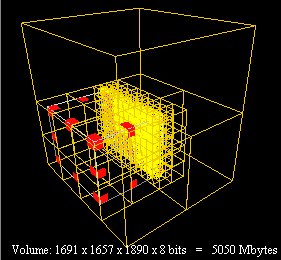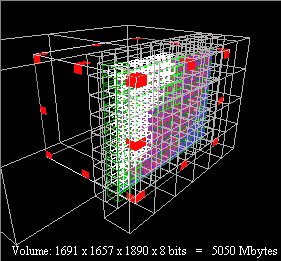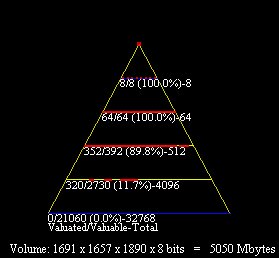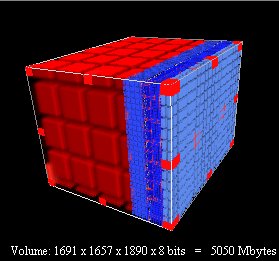 Global resource parameters of VolumeViz.
More...
Global resource parameters of VolumeViz.
More...
#include <LDM/SoLDMGlobalResourceParameters.h>
Public Types | |
| enum | VisualFeedbackParam { DRAW_TILES , DRAW_SLICES_TEX , DRAW_TOPOLOGY , DRAW_TILE_OUTLINE , SHOW_TILES_VALUATED , SHOW_LOAD_UNLOAD_TILES , USE_FAKE_DATA } |
| Visual feedback modes. More... | |
| typedef void | SoLDMLoadCB(SbBool startLoading, void *userData) |
| Loading callback for LDM mode. | |
| typedef void | SoLDMMonitoringCB(SoDataSet *dataSet, double elapsedTime, double memLoaded, void *userData) |
| Monitoring callback for LDM mode. | |
Static Public Member Functions | |
| static void | setMaxMainMemory (int maxMainMemory) |
| Sets the maximum main (CPU) memory, in MB, to use for all VolumeViz data sets. | |
| static int | getMaxMainMemory () |
| Returns the maximum main memory in MB for all the VolumeViz data sets. | |
| static void | setMaxTexMemory (int maxTexMemory) |
| Sets the maximum texture (GPU) memory, in MB, for all VolumeViz data sets. | |
| static int | getMaxTexMemory () |
| Returns the maximum texture memory in MB for all the VolumeViz data sets. | |
| static void | setTex3LoadRate (int loadRate) |
| Sets the maximum number of 3D textures allowed to be downloaded into texture (GPU) memory, per frame (render traversal), for all VolumeViz data sets. | |
| static int | getTex3LoadRate () |
| Returns the maximum number of tiles (3D textures) allowed to be downloaded into texture (GPU) memory per frame for all the VolumeViz data sets. | |
| static void | setTex2LoadRate (int loadRate) |
| Sets the maximum number of 2D textures allowed to be downloaded into texture (GPU) memory per frame (render traversal) for all the VolumeViz data sets. | |
| static int | getTex2LoadRate () |
| Returns the maximum number of 2D textures allowed to be loaded into texture memory per frame for all the VolumeViz data sets. | |
| static void | setNumIO (unsigned int numIO) |
| Sets how many simultaneous tile loading threads to use if multi I/O mode is on (it is on when LDM mode is on). | |
| static unsigned int | getNumIO () |
| Returns the current number of loading threads. | |
| static void | setVisualFeedbackParam (VisualFeedbackParam param, SbBool state) |
| Sets the specified visual feedback parameter to true or false. | |
| static SbBool | getVisualFeedbackParam (VisualFeedbackParam param) |
| Returns the state of the specified visual feedback parameter. | |
| static void | setViewCulling (SbBool state, SbBool forceRedraw=TRUE) |
| Sets the view culling flag. | |
| static SbBool | getViewCulling () |
| Returns the view culling flag. | |
| static void | setScreenResolutionCulling (SbBool flag) |
| Sets the screen resolution culling flag. | |
| static SbBool | getScreenResolutionCulling () |
| Returns the screen resolution culling state. | |
| static void | setIgnoreFullyTransparentTiles (SbBool state) |
| Sets the IgnoreFullyTransparentTiles flag. | |
| static SbBool | getIgnoreFullyTransparentTiles () |
| Returns the IgnoreFullyTransparentTiles flag. | |
| static void | setViewpointRefinement (SbBool state) |
| Sets the viewpoint refinement flag. | |
| static SbBool | getViewpointRefinement () |
| Returns the viewpoint refinement flag. | |
| static void | setSliceEqualResolution (SbBool state, SbBool forceRedraw=TRUE) |
| Sets the slice equal resolution flag. | |
| static SbBool | getSliceEqualResolution () |
| Returns the slice equal resolution flag. | |
| static void | setLoadNotificationRate (int) |
| Sets the load notification rate (number of tiles). | |
| static int | getLoadNotificationRate () |
| Returns the load notification rate. | |
| static void | setLoadCB (SoLDMLoadCB *func, void *userData=NULL) |
| Sets a callback to be called with the tile loading state. | |
| static void | setMonitoringCB (SoLDMMonitoringCB *func, int memAmount, void *userData=NULL) |
| Sets a monitoring callback . This provides a snapshot of the tile loading performance. | |
| static int64_t | getDefaultMaxTexMem () |
| Returns the default maximum GPU memory in MB. | |
| static int64_t | getDefaultMaxMainMem () |
| Returns the default maximum system (CPU) memory in MB. | |
| static void | setMax2DTexMemory (uint64_t maxMemory) |
| Sets the maximum 2D texture GPU memory in MB allowed to be loaded for all VolumeViz data sets. | |
| static uint64_t | getMax2DTexMemory () |
| Get the maximum number of 2D textures allowed to be loaded. | |
Deprecated | |
| static SoDEPRECATED void | setMoveLowResolution (SbBool state) |
| Sets the low resolution when moving flag. | |
| static SoDEPRECATED SbBool | getMoveLowResolution () |
| Returns the move low resolution flag. | |
 Global resource parameters of VolumeViz.
Global resource parameters of VolumeViz.
This class defines functions for controlling global resource parameters of VolumeViz.
These parameters can have a significant impact on resource usage (primarily memory) data loading and rendering performance.
Memory management
This class allows the application to specify how much CPU and GPU memory VolumeViz can use to load data and textures. By default the main memory and texture memory limits are set to a percentage of the total available system and GPU memory (see the setMaxMainMemory(), setMaxTexMemory() and setMax2DTexMemory() methods). Applications can use the SoCpuDevice and SoGLDevice classes to query the total and available memory on the CPU and GPU. How VolumeViz uses CPU memory depends on the data source (tiled or not tiled), and the selected tile cache policy (see the field SoLDMResourceParameters::tileCachePolicy).
Tiles:
VolumeViz uses a data manager called LDM to manage volume data. LDM manages volume data in chunks called "tiles". If the volume size is larger than the tile size, then there are two classes of tile: full-resolution tiles that contain actual data values and low-resolution tiles that contain sub-sampled data values. The application may have native data that is already tiled or the data may be pre-processed to create tiles and store them in the LDM file format. In an LDM format file the tiles may optionally be compressed to save disk space and memory, but in this case, the tiles must be expanded before sending to the GPU. If the data is not tiled, for example disk formats like DICOM and SEGY or an in-memory volume, then tiles must be created in memory at runtime.
Tile size:
Note that the default tile size is small and generally you will get better performance with non-tiled data by explicitly setting a larger tile size (see the ldmResourceParameters field and SoLDMResourceParameters::tileDimension). If the volume data fits in CPU and GPU memories, the tile size may be set to the volume dimension to mimic non-tiled volume data behavior (i.e., without multi-resolution).
Caches:
VolumeViz allocates a significant amount of memory on the CPU to store tile data and on the GPU to process the rendering. The chosen amounts of memory are a trade off between efficient data loading and rendering performance. If the volume is larger than the available or allowed memory, the most important tiles are kept in memory. The importance is determined by various heuristics set in this class and in SoLDMResourceParameters.
First level CPU tile cache (controlled by max main memory)
VolumeViz uses this amount of CPU memory as a first level cache for LDM data tiles. The main memory limit is set in megabytes using the setMaxMainMemory() method. If the data set is small enough to fit in system memory, then you should generally set the memory limit high enough to allow this. If the data set is larger than system memory, then set the memory limit as high as possible without impacting the application's other needs for memory. For example, if the tile size is 64 and each voxel is a float value, then each tile requires approximately 1 MB of system memory. However the CPU memory footprint can be reduced for compressed tiles (stored compressed) depending on the selected SoLDMResourceParameters::tileCachePolicy.
When there are multiple data sets, by default each data set receives getMaxMainMemory() divided by the number of datasets. Each time a new data set is created the per-dataset value is recomputed and some memory is taken away from existing data sets. Note: This default way to allocate memory (when handling multiple data sets) is not optimal if the data sets have significantly different sizes. For example, the memory required for a height field is normally much less than for a volume. In this case the application can explicitly allocate memory to each data set using the field SoLDMResourceParameters::maxMainMemory associated with the data set (see the SoDataSet::ldmResourceParameters field).
Second level CPU tile cache
VolumeViz also uses a second cache of tiles in CPU memory that is used when some tiles must be created or uncompressed on the fly. This second level cache is normally used when a tile must be sent to the GPU but it is not used when the SoLDMResourceParameters::tileCachePolicy is ALL. This cache has a short life cycle thus the tiles might only be temporarily stored in this cache.
Warning:
This second cache is separate from the first level CPU cache and its footprint is not included in the limit specified by maxMainMemory (neither setMaxMainMemory nor SoLDMResourceParameters::maxMainMemory). Even if the variable OIV_BUFFER_OBJECT_CACHE_SIZE is deprecated, it can be set as a workaround. It defines the maximum number of tiles that can be stored in the second level cache.
GPU Tile Cache (controlled by max texture memory)
VolumeViz uses this amount of GPU memory to cache LDM data tiles on the GPU. The texture memory limit is set in megabytes using the setMaxTexMemory() method for for 3D tiles and by the setMax2DTexMemory() method for the 2D tiles. You can set these values separately for each data set using SoLDMResourceParameters.
Warning:
Some systems integrate GPU memory with CPU memory. In this case, if you allocate 4GB of CPU memory and 4GB of GPU memory, the system may see a total of 8GB private memory used by the process, leading to out-of-memory errors or swapping issues. If you face such issues, you should ensure that the max CPU memory + max GPU memory is less than the total available CPU memory for your machine.
Notes:
SoLDMGlobalResourceParameters values are initialized by SoLDMLargeDataManagement::init(), so SoLDMGlobalResourceParameters methods must be called after calling SoLDMLargeDataManagement::init() or SoVolumeRendering::init()
SoDataSet, SoVolumeData, SoLDMResourceParameters
Definition at line 163 of file SoLDMGlobalResourceParameters.h.
| typedef void SoLDMLoadCB(SbBool startLoading, void *userData) |
Loading callback for LDM mode.
Called with TRUE means the process starts loading. FALSE means the process is done loading.
Definition at line 41 of file SoLDMGlobalResourceParameters.h.
| typedef void SoLDMMonitoringCB(SoDataSet *dataSet, double elapsedTime, double memLoaded, void *userData) |
Monitoring callback for LDM mode.
Reports how much time is needed to load a given amount of data. The amount of data is specified when setting the CB.
Definition at line 52 of file SoLDMGlobalResourceParameters.h.
Visual feedback modes.
Used with setVisualFeedbackParam() method.
| Enumerator | |
|---|---|
| DRAW_TILES | Draw the tiles of SoVolumeRender or SoVolumeSkin primitives. They are drawn by default. |
| DRAW_SLICES_TEX | Use texturing for SoOrthoSlice, SoObliqueSlice, and SoVolumeGeometry primitives. They are used by default. |
| DRAW_TOPOLOGY | Show tiles loaded in main memory. This implies showing the multiresolution topology. The tile outlines of tiles of full resolution are drawn with a brighter yellow. The topology is not drawn by default. 
|
| DRAW_TILE_OUTLINE | Draw tile outlines for all primitives. The tile outline of tiles of full resolution are drawn with a brighter gray for the volume, and a brighter green for the slices. Outlines are not drawn by default. 
|
| SHOW_TILES_VALUATED | Show tiles visited by the Tile Visitor. They are not shown by default. For the default LDM implementation, displays an octree representation showing traversal of the octree. Red dots are tiles that have been valuated. Blue indicates the minimum and maximum resolution thresholds. Yellow shows the octree itself. 
|
| SHOW_LOAD_UNLOAD_TILES | Show tiles loaded (in red) and unloaded (in blue) in texture memory. They are not shown by default. |
| USE_FAKE_DATA | Use fake data instead of the real data during loading into main memory. The fake data is programmatically generated and is designed to illustrate features of Large Data Management. Fake data is not used by default. 
|
Definition at line 281 of file SoLDMGlobalResourceParameters.h.
|
inlinestatic |
Returns the default maximum system (CPU) memory in MB.
Definition at line 477 of file SoLDMGlobalResourceParameters.h.
|
inlinestatic |
Returns the default maximum GPU memory in MB.
Definition at line 472 of file SoLDMGlobalResourceParameters.h.
|
static |
Returns the IgnoreFullyTransparentTiles flag.
|
static |
Returns the load notification rate.
|
static |
Get the maximum number of 2D textures allowed to be loaded.
See setMax2DTexMemory.
|
static |
Returns the maximum main memory in MB for all the VolumeViz data sets.
See setMaxMainMemory.
|
static |
Returns the maximum texture memory in MB for all the VolumeViz data sets.
See setMaxTexMemory.
|
static |
Returns the move low resolution flag.
|
static |
Returns the current number of loading threads.
See setNumIO().
|
static |
Returns the screen resolution culling state.
|
static |
Returns the slice equal resolution flag.
|
static |
Returns the maximum number of 2D textures allowed to be loaded into texture memory per frame for all the VolumeViz data sets.
See setTex2LoadRate().
|
static |
Returns the maximum number of tiles (3D textures) allowed to be downloaded into texture (GPU) memory per frame for all the VolumeViz data sets.
See setTex3LoadRate().
|
static |
Returns the view culling flag.
See setViewCulling().
|
static |
Returns the viewpoint refinement flag.
|
static |
Returns the state of the specified visual feedback parameter.
|
static |
Sets the IgnoreFullyTransparentTiles flag.
Default is FALSE. When TRUE, tiles for which all voxels between their min and max values are fully transparent (alpha = 0) will not be refined. In other words a low resolution version will always be used. This can reduce memory requirements for volumes with significant "empty space".
|
static |
Sets a callback to be called with the tile loading state.
The callback function is called with true when the process starts loading tiles. And with false when loading is complete, in other words when LDM has the best possible set of tiles in memory for the current render nodes, viewpoint, etc.
NOTE: This feature is available with VolumeVizLDM only.
|
static |
Sets the load notification rate (number of tiles).
When rate new tiles have been loaded in main memory, a redraw will be scheduled. This is useful because tiles are loaded asynchronously using multiple threads. The default is 50 tiles. Which means, for example, if each voxel is one byte and the tileSize is 64x64x64, a redraw will be scheduled whenever 13 MB of data has been loaded.
|
static |
Sets the maximum 2D texture GPU memory in MB allowed to be loaded for all VolumeViz data sets.
The sum of 2D texture memory allowed per data set (see SoLDMResourceParameters::max2DTextures field) must be less than or equal to this value. The total amount of GPU memory allowed is set using the setMaxTexMemory method. This method limits the amount of GPU memory that can be used by (for example) SoOrthoSlice and SoVolumeSkin nodes. This can be useful when combining slices and volume rendering because the 3D textures used by volume rendering require much more GPU memory. Default is 5% of GPU memory available at application startup.
|
static |
Sets the maximum main (CPU) memory, in MB, to use for all VolumeViz data sets.
You can also set the maximum main memory for each data set separately using the maxMainMemory field of the data set's SoLDMResourceParameters object (see SoDataSet::ldmResourceParameters). The sum of all per data set values must be less than or equal to the value set here.
Default (since Open Inventor 8.1) is 50% of total CPU memory up to 70% of free memory. See SoCpuDevice to query available CPU memory.
|
static |
Sets the maximum texture (GPU) memory, in MB, for all VolumeViz data sets.
You can also set the maximum texture memory for each data set separately using the maxTexMemory field of the data set's SoLDMResourceParameters object (see SoDataSet::ldmResourceParameters). The sum of all per data set values must be less than or equal to the value set here.
Default is 75% of GPU memory available at application startup. See SoGLDevice to query available GPU memory.
|
static |
Sets a monitoring callback . This provides a snapshot of the tile loading performance.
The callback will be called each time memAmount MB of data have been loaded, with the amount of data and the amount of time elapsed to load that data.
NOTE: This feature is available with VolumeVizLDM only.
|
static |
Sets the low resolution when moving flag.
Default is FALSE. When TRUE, lower resolution tiles are automatically used while the camera is moving (e.g. when user is panning and rotating.
|
static |
Sets how many simultaneous tile loading threads to use if multi I/O mode is on (it is on when LDM mode is on).
The IVVR_NUM_LOADERS preference (see SoPreference) lets you choose the initial number of loading threads at launch. Changing this preference at runtime will not affect the actual number of loading threads, use this method instead. If this preference is not set, the default is 4.
The IVVR_MAX_NUM_LOADERS preference lets you set a maximum number of tile loading threads. If this method is called with a larger number, the number of loading threads will be set to the maximum instead. If this preference is not set, the maximum is 20.
|
static |
Sets the screen resolution culling flag.
Default is FALSE. When TRUE, only tiles for which the projection of a voxel is greater than or equal to 1 pixel on screen will be loaded. This avoids unnecessary loading of high resolution data for large volumes. However if you "zoom out" from a volume, it does not force lower resolution tiles to be used (high resolution tiles already in memory will still be used). If necessary use the SoLDMResourceParameters::fixedResolution field to force use of lower resolution tiles.
|
static |
Sets the slice equal resolution flag.
Default is FALSE. When TRUE, slice primitives, e.g. SoOrthoSlice and SoObliqueSlice, are always rendered using a set of tiles at the same resolution level. This avoids potentially distracting visual effects caused by mixing tiles of different resolution on the same slice. But it means that the slice will be rendered at a lower resolution if it is not possible to load every tile needed for the higher resolution. When FALSE and viewpoint refinement is enabled, higher resolution tiles will be loaded for portions of the slice closer to the camera even if it is not possible to load every high resolution tile.
An alternative strategy is to enable the SoSlice::largeSliceSupport field. When large slice support is enabled, if all the required full resolution tiles have already been loaded, then the slice data is taken from LDM cache memory as usual. But if some required tiles are not currently in memory, the full resolution slice data will be loaded directly from the volume reader without loading the complete tiles. This reduces disk I/O and reduces the amount of system memory required to display the slice at full resolution, so larger (or more) slices can be displayed.
|
static |
Sets the maximum number of 2D textures allowed to be downloaded into texture (GPU) memory per frame (render traversal) for all the VolumeViz data sets.
You can set this parameter separately for each data set using field SoLDMResourceParameter::tex2LoadRate. Default is 100 2D textures per frame.
Each tile needed to render a slice (SoOrthoSlice, SoVolumeSkin, etc) must be loaded into GPU memory as a 2D texture. Increasing the loadRate value reduces the number of frames required to reach maximum resolution. But the render traversal has to wait for the data transfer to finish, so each frame may take longer to render, increasing the total time to reach maximum resolution.
|
static |
Sets the maximum number of 3D textures allowed to be downloaded into texture (GPU) memory, per frame (render traversal), for all VolumeViz data sets.
You can set this parameter separately for each data set using field SoLDMResourceParameter::tex3LoadRate. Default is 10 3D textures (effectively 3 tiles) per render traversal.
Each tile needed for volume rendering (SoVolumeRender) and volume geometry must be transfered to GPU memory as a 3D texture. So, for example, transfering 1000 tiles at the default loadRate (10) requires 100 frames. (How many seconds this takes depends on the frames per second possible, which in turn depends on many factors including the complexity of the scene graph.) Increasing the loadRate value reduces the number of frames required to reach maximum resolution. But the render traversal has to wait for the data transfer to finish, so each frame may take longer to render, increasing the total time to reach maximum resolution.
|
static |
Sets the view culling flag.
Default is TRUE. When TRUE, only tiles that are inside the view frustum (i.e. visible) will be loaded and conversely tiles that are outside the view frustum may be discarded.
|
static |
Sets the viewpoint refinement flag.
Default is TRUE. When TRUE, tile refinement depends on the viewpoint. In other words, tiles closer to the camera have higher priority and higher resolution data will be loaded for closer tiles first. This can be useful for large volumes that cannot be completely loaded in memory.
|
static |
Sets the specified visual feedback parameter to true or false.